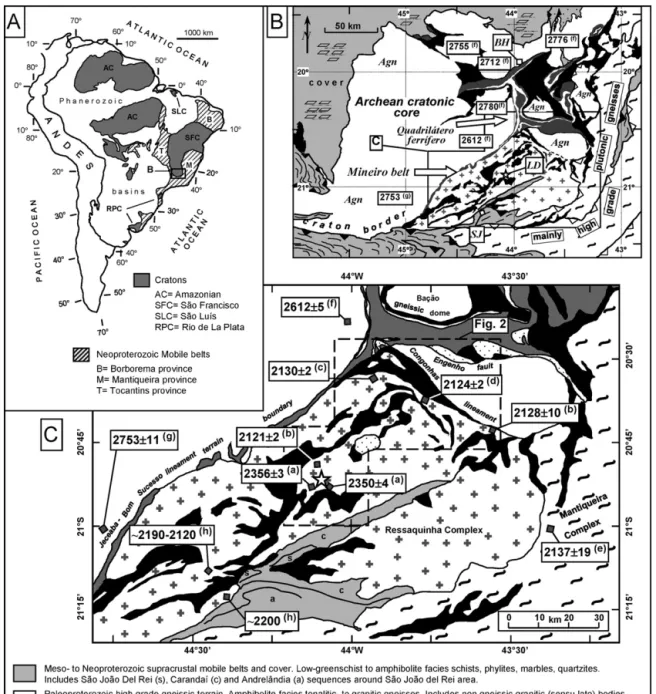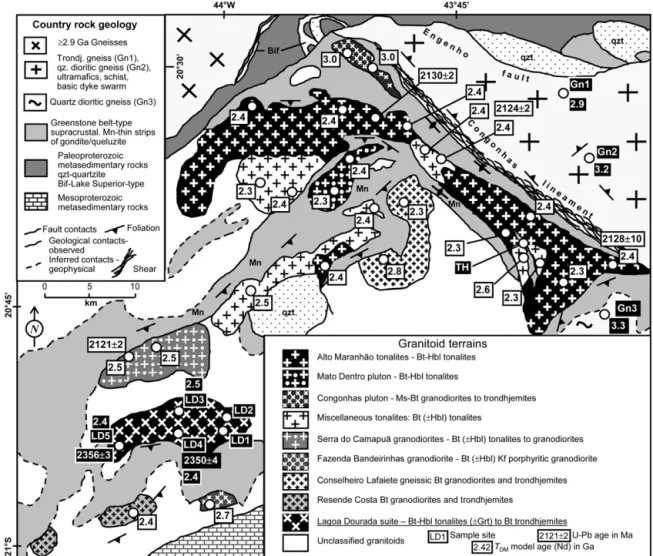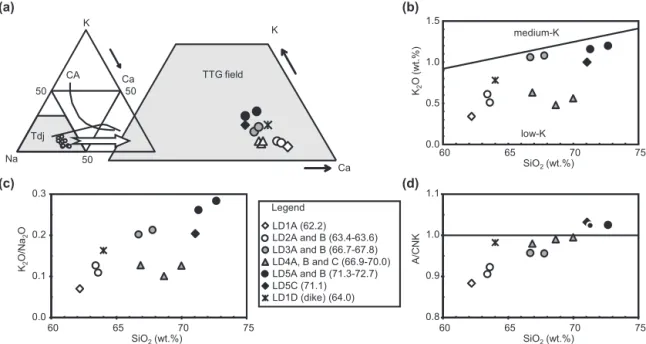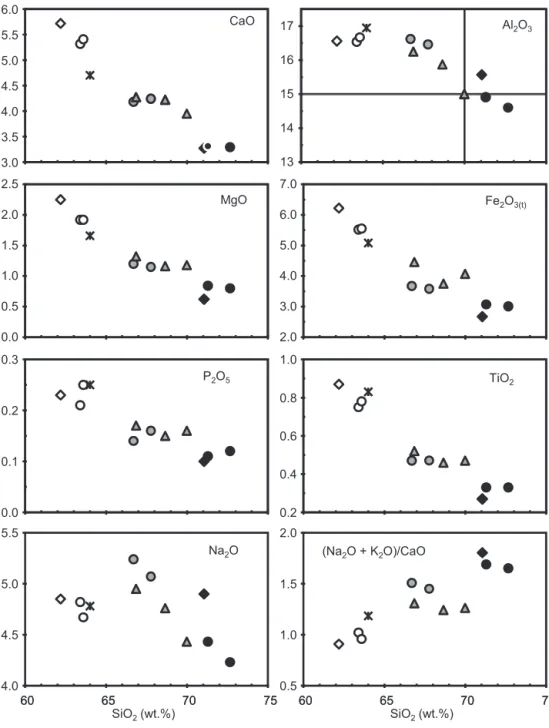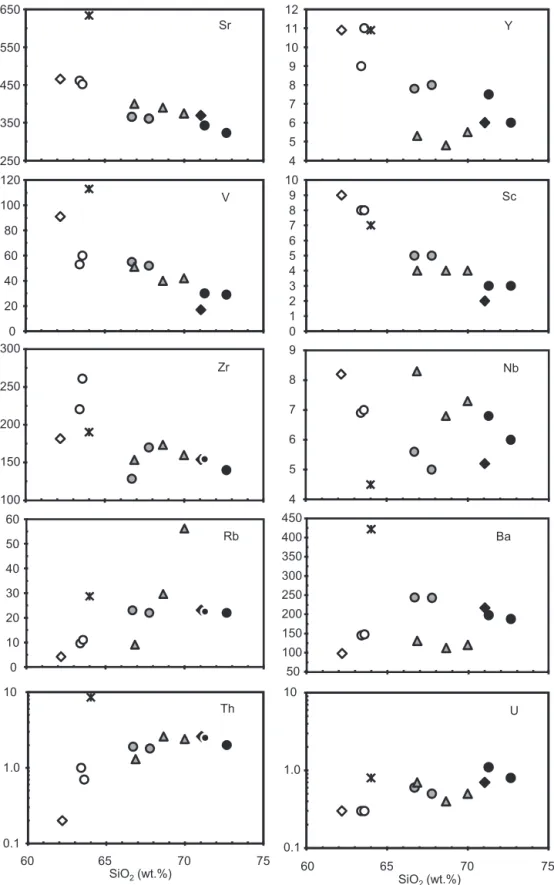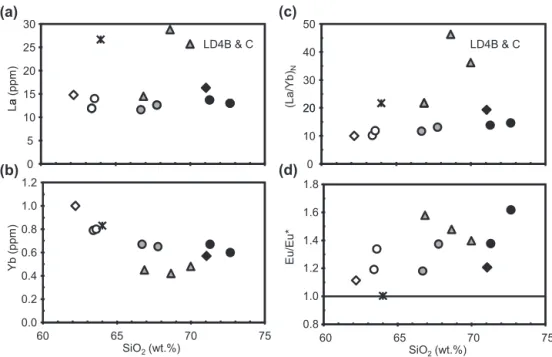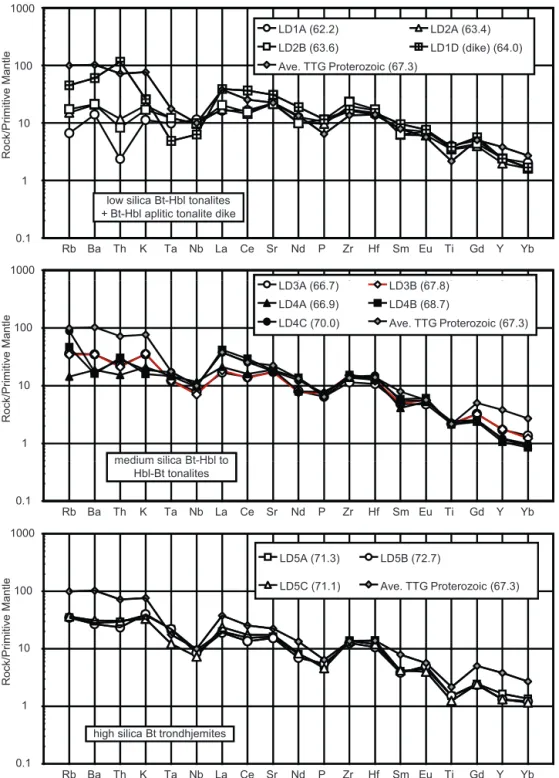Contents
lists
available
at
SciVerse
ScienceDirect
Precambrian
Research
j o u r n a
l
h
o m e p a
g
e :
w w w . e l s e v i e r . c o m / l o c a t e / p r e c a m r e s
Geochemistry,
Nd
isotopes
and
U–Pb
geochronology
of
a
2350
Ma
TTG
suite,
Minas
Gerais,
Brazil:
Implications
for
the
crustal
evolution
of
the
southern
São
Francisco
craton
Luís
Antônio
Rosa
Seixas
a
,
∗
,
Jean
David
b
,
Ross
Stevenson
b
aDepartamentodeGeologia,UniversidadeFederaldeOuroPreto,MorrodoCruzeiro,CEP35400-000,OuroPreto,Brazil bGEOTOPUniversitéduQuébecàMontréal,P.O.Box8888,StationCentreVille,Montréal,QuébecH3C3P8,Canada
a
r
t
i
c
l
e
i
n
f
o
Articlehistory:
Received24June2011 Receivedinrevisedform 11November2011 Accepted11November2011
Available online 22 November 2011
Keywords:
TTG Ndisotopes U–Pbgeochronology Geochemistry 2350Ma
SãoFranciscocraton
a
b
s
t
r
a
c
t
ThePaleoproterozoicisconsideredthemainperiodofcrustalgrowthintheSouthAmericancontinent, withvoluminousproductionofgranitoidsuitesemplacedduringtheonsetoftheca.2.2–2.1Ga Trans-Amazonianorogeny.Thisworkdocumentsandinterpretsmineralchemistry,wholerockgeochemistry, NdisotopesandU–Pbgeochronologydataforthehigh-aluminiumLagoaDouradaTTGsuite.Thissuite constitutesahithertounknownepisodeofPaleoproterozoic(ca.2350Ma)juvenilefelsicplutonisminthe southernSãoFranciscocraton,MinasGerais,Brazil.Itisalsoarareexampleofjuvenilecontinentalcrust productionintheglobalcrustalage-gapbetween2.45and2.2Ga.Thesuiteiscomposedof metalumi-noustoslightlyperaluminous,low-Mg#,low-Kandhigh-Ca,biotite-hornblendetohornblende-biotite (±garnet-magnetite)tonalitesandbiotitetrondhjemites,varyingfrom∼62to73wt.%SiO2.Thetrace
ele-mentgeochemistryofthesuiteischaracterizedbymildlydepletedNdisotopecompositions[εNd(t)=+1.0
to+2.1],lowlarge-ion-lithophileelement(LILE,i.e.,Rb,Ba,andincludingthehighlyincompatibleTh)and heavyRareEarthelement(REE,Yb<1.00ppm)contents.ThesuiteisalsocharacterizedbyhighSr/Yratios (≥41upto81),high(La/Yb)Nratios(≥12upto46),andpositiveEu/Eu*anomalies.Thesedataare
con-sistentwiththederivationofthesuitefromatholeiiticmetabasalticsource,whichhadashortcrustal residencetimepriortomelting.Thechemicaldiversityofthesuiteisattributedmainlytothe frac-tionalcrystallizationofhornblendeandaccessoryminerals,coupledwithplagioclaseaccumulationin thetonaliticparentalmelt.Emplacementofnewbatchesofmagmacouldexplainsampleswhichdiverge fromtheproposedliquidlineofdescentofthesuite.ThecompositionandageoftheLagoaDouradasuite suggestalinkwiththeaccretionofgreenstonebeltpackagesinanintra-oceanictectonicsetting.
© 2011 Elsevier B.V. All rights reserved.
1.
Introduction
High-aluminium
tonalite–trondhjemite–granodioritic
suites
(TTG
suites,
Barker,
1979;
Condie,
2005;
Martin
et
al.,
2005
)
are
characterized
by
Mg#
≤
50
(Mg#
=
100
×
mol
MgO/[MgO
+
FeO
t]),
low
Cr
and
Ni
(average
29
and
14
ppm,
respectively),
high
Al
2O
3(>15%
at
70%
SiO
2),
high
Sr
(>300
ppm)
and
strongly
fractionated
light/heavy
REE
patterns,
with
low
heavy
REE
(Yb
<
1.8
ppm)
and
Y
(<20
ppm).
A
number
of
geochemical,
petrologic
and
experimental
studies
have
shown
that
these
suites
can
be
derived
from
partial
melting
of
tholeiitic
metabasaltic
rocks,
leaving
garnet
amphibolite
to
eclogite
residues
(
Martin,
1986;
Drummond
and
Defant,
1990;
Rapp
and
Watson,
1995;
Rapp,
1997;
Willie
et
al.,
1997;
Clemens
∗Correspondingauthor.Tel.:+553135591600;fax:+553135591606.
E-mailaddress:luseixas@degeo.ufop.br(L.A.R.Seixas).
et
al.,
2006
).
Tectonic
settings
suggested
for
these
suites
commonly
include
amphibolitic
lower
continental
crust,
mafic
rocks
at
the
base
of
thickened
arc
crust
or
at
the
roots
of
an
oceanic
plateau,
or
young
descending
slabs
(
Martin,
1986;
Drummond
et
al.,
1996;
Petford
and
Atherton,
1996;
Barnes
et
al.,
1996;
White
et
al.,
1999;
Whalen
et
al.,
2002;
Smithies
et
al.,
2003
).
TTG
suites
with
Nd
isotope
compositions
in
the
range
of
depleted
mantle
values
at
the
time
of
crystallization
are
attributed
to
be
a
consequence
of
the
two
step
model
for
the
generation
of
these
rocks:
extraction
of
basaltic
precursors
from
the
mantle,
followed
soon
after
by
high
pressure
melting
at
garnet
amphibolitic
to
eclogitic
conditions,
in
order
to
preserve
the
isotopic
composition
of
the
mafic
protolith
(
Martin,
1987;
Barnes
et
al.,
1996;
Clemens
et
al.,
2006;
Stevenson
et
al.,
2009
).
The
Paleoproterozoic
is
a
particularly
important
period
of
crustal
growth
for
the
South
American
continent,
with
the
pro-duction
of
numerous
juvenile,
subduction-zone
related
granitoid
0301-9268/$–seefrontmatter© 2011 Elsevier B.V. All rights reserved.
62 196–197 (2012) 61–80
Fig.1.ThesouthernSãoFranciscocraton(SFC)inrelationtothemajortectonicunitsoftheSouthAmericacontinent(A).BoxesBandCshowthelocationoftheLagoa Douradasuite(star)insidetheMineirobelt.
AdaptedwithmodificationsfromHartmannandDelgado(2001,A),Teixeiraetal.(2000,B)andHeinecketal.(2003,BandC).Theageofcrystallizationofselectedgranitoid suites(millionyears)arehighlightedinthelittleboxesinBandC.Sourceofdata:(a)thisarticle;(b)unpublished,firstauthor’sdata;(c)Noce(1995);(d)Noceetal.(2000); (e)Noceetal.(2007a);(f)Noceetal.(2007b);(g)CamposandCarneiro(2008);(h)Ávilaetal.(2010,andreferencestherein,rangeofagesfromdifferentplutons).Legendof citiesinB:BH:BeloHorizonte,LD:LagoaDourada,SJ:SãoJoãoDelRei.
suites
associated
with
the
ca.
2.2–2.1
Ga
Trans-Amazonian
orogeny
(
Cordani
and
Sato,
1999;
Almeida
et
al.,
2000
).
This
paper
provides
new
mineralogical,
whole
rock
geochemical,
U–Pb
and
Nd-isotope
data
for
the
Lagoa
Dourada
TTG
suite.
This
ca.
2350
Ma
suite
Fig.2.GeologicalcontextoftheLagoaDouradasuiteinrelationtothesurroundinggranitoidterrains,southernQuadriláteroFerríferoarea.Classificationofthegranitoid suitesaccordingtofirstauthor’sunpublisheddata(seesummaryinTable1).
Source:GeologyadaptedfromHeinecketal.(2003)withmodifications.
2.
Geological
setting
The
Lagoa
Dourada
suite
outcrops
within
a
Paleoprotero-zoic
belt
bordering
the
Archean
nuclei
of
the
southern
São
Francisco
craton,
on
the
southern
edge
of
the
Quadrilátero
Fer-rífero
region,
Minas
Gerais,
southeastern
Brazil
(
Fig.
1
).
This
region
is
known
for
its
abundance
of
Late-Archean
and
Pale-oproterozoic
rock-packages
and
comprises
one
of
the
most
important
gold
and
iron
provinces
of
the
South
American
con-tinent
(
Almeida
et
al.,
2000;
Hartmann
and
Delgado,
2001
).
The
Archean
rocks
of
the
Quadrilátero
Ferrífero
area
consist
of
the
well-preserved
ca.
2.77
Ga
Rio
das
Velhas
greenstone
belt,
with
greenschist
to
low-amphibolite
facies
volcano-sedimentary
suc-cessions
dominated
by
tholeiitic
and
komatiitic
volcanic
rocks
and
acid
volcaniclastics,
followed
by
volcano-exhalative
banded
iron
formations
and
upper
turbiditic,
graywacke-sandstone
and
conglomerate-sandstone
formations
(
Noce
et
al.,
2005;
Baltazar
and
Zuchetti,
2007
).
The
greenstone
belt
is
surrounded
by
>2.9
Ga
high
grade
banded
TTG
gneisses
and
intrusive
Neoarchean
tonalitic
to
granitic
plutonic
suites
(
Machado
et
al.,
1992;
Machado
and
Carneiro,
1992;
Teixeira
et
al.,
1996;
Noce
et
al.,
2007b
).
The
Archean
rocks
are
covered
by
a
thick
platformal
metasedi-mentary
sequence–the
Minas
Supergroup,
deposited
between
∼
2.5
and
2.12
Ga
(
Dorr,
1969;
Machado
et
al.,
1996;
Alkmim
and
Marshak,
1998;
Hartmann
et
al.,
2006
).
Extensive
areas
of
intermediate
to
felsic
plutonic
rocks
are
exposed
on
the
southern
and
eastern
edge
of
the
Quadrilátero
Ferrífero
and
are
collec-tively
grouped
into
a
single
lithotectonic
unit
referred
to
as
Mineiro
belt
(
Fig.
1
,
Noce
et
al.,
2000;
Teixeira
et
al.,
2000
).
The
plutonic
rocks
of
the
Mineiro
belt
intrude
elongated
green-stone
belts
trending
NE–SW
from
Congonhas
lineament
in
the
north,
to
São
João
Del
Rei
in
the
southwest
(
Fig.
1
).
These
supracrustal
sequences
are
composed
mainly
of
tholeiitic
and
komatiitic
metavolcanic
rocks
interleaved
with
metamorphosed
volcano-exhalative
manganese
sedimentary
rocks
(
Toledo,
2002;
Ávila
et
al.,
2010
).
The
Mineiro
belt
is
broadly
divided
into
a
western
and
an
eastern
domain.
The
western
domain
(
Fig.
1
)
consists
of
wide
areas
of
mas-sive
to
variably
deformed
tonalitic,
trondhjemitic
and
granodioritic
to
granitic
plutons
(including
the
Lagoa
Dourada
suite),
and
minor
scattered
gabbroic
and
dioritic
bodies,
all
of
which
are
partially
overlain
by
the
low
greenschist
facies
metasedimentary
rocks
of
the
Mesoproterozoic
to
Neoproterozoic
São
João
Del
Rei
and
Andrelân-dia
Groups.
The
eastern
domain
of
the
Mineiro
belt
is
characterized
by
a
predominance
of
homogeneous
to
banded
medium-
to
high-grade
plutonic
orthogneisses-labeled
as
Mantiqueira
Complex
in
64 196–197 (2012) 61–80
Table1
SumaryoffieldandpetrographicfeaturesforgranitoidsandassociatedcountryrocksfromsouthernQuadriláteroFerríferoregion,MinasGerais.
Group Fieldaspects.Knownareal
exposition(KAE)
QAPclassif.Ab-An-Or classif.
%ofmaficminerals Accessoryminerals
LagoaDouradasuite Foliatedtogneissic,withvariable
grainsizeandmaficmineral contents.Intrudedbymultiple crosscuttingapliticdiking. KAE>50km2.
TotoTdj To
<10%to25% Hblabsentto>Bt
Ap,Zrn,Ttn,Alnand±Grt,
withMgt.Magneticin handspecimen
AltoMaranhãotonalite Abundantmagmamingling
structureswithdioriticmagmatic enclaves.Generallywellfoliated andwithmultiplesyn-to post-magmaticdiking.KAE>100to 250km2.
Qz-DitoTo To/Gd(±Tdj)
15–45%
Hbl:Btratio0.8–1.3
Ap,Zrn,Aln,Ilm,Ttn. GrowthofEpoverAln
MatoDentropluton Abundantmagmamingling
structureswithdioriticmagmatic enclavesinthemostmaficportions ofthepluton.KAE>15to30km2.
TotoGd To
<10%to25% Hblmaybeabsent
SameasAltoMaranhão tonalite
Congonhaspluton Massivetofoliatedorsheared,
withheterogeneousbiotite distribution,fromrandomly scatteredtoclusteredinbiotite richcentimeterscalemicaceous enclaves.KAE<20km2.
GdtoTdj
TdjandboundaryTdj/Gt
<10%,withBtandMs MainlyZrnandAp.Biotite richenclaveswithMs,Ilm, Ttn,Zrn,Ap,andrareAln.
Miscelaneoustonalites Scarcedioriticmagmaticenclaves. Wellfoliated,sometimesgneissic inshearzones.Locallywith xenolithsand/orroofpendantsof amphibolitecountryrocks. KAE>50km2.
To/TdjorGd To/Tdj
<10%to20%
Hblabsentorsubortinate toBt
SameasAltoMaranhão tonalite
SerradoCamapuãtonalites Scarcedioriticmagmaticenclaves, withamphibolitewallrock xenoliths.Slightlytowellfoliated. KAE>50km2.
TotoGd
To/Tdj/Gdboundary
<10%to15% Hblabsentorvery subortinatetoBt
SameasAltoMaranhão tonalite
FazendaBandeirinhas granodiorite
Kf-porphyriticHbl-Btgranodiorite, wellfoliatedtogneissic,with foldedfelsicleucocraticapliticand pegmatiticdikes.KAEnot determined.
Gd Gd
<10%to20%
Hblabsentorsubortinate toBt
Sameasprevious,withMgt insteadofIlm.Magneticin handspecimen
ConselheiroLafaiete trondhjemitesand grano-diorites
Foliatedtogneissic,locallywith complexfoldpatternsandmultiple felsictrondhjemiticandgranitic dyking.KAE>50km2.
GdandTdj Gd/Tdj/Gtboundary
≤10%,onlyBt,partially
replacedbymuscovite
Ap,Zrn,Ttn,Aln.Growthof EpoverAln
ResendeCostagranodio– rites
Homogeneouswellfoliated,with deformedapliteandpegmatite dikes.KAEnotdetermined.
GdtoTdj GdandTdj
≤10%,onlyBt Ap,Zrn,Ttn,Aln.Growthof
EpoverAln
TH–countryrock amphibolite
Foliated,finetomediumgrained maficamphibolite.Occursasroof pendantsorxenolithsonvarious granitoids.ContainsHbl,Pl,Qtz, Ttn,Epandopaqueminerals.Btis locallyobserved.
Gn1–trondhjemiticgneiss Foliatedtobanded,medium grainedbiotitetonaliticto trondhjemiticorthogneiss. Gn2–qzdioriticgneiss Bandedmediumgrained
biotite-hornblende-quartz-plagioclase gneiss.WithaccessoryTtn,Ep,Aln, Zrn,Apandopaqueminerals.
Gn3–qzdioriticgneiss Bandedandcomplexelyfolded
mediumgrained biotite-hornblende-quartz-plagioclase gneiss.WithTtn,Epandopaque minerals.
Apatite(Ap),allanite(Aln),biotite(Bt),epidote(Ep),hornblende(Hbl),ilmenite(Ilm),magnetite(Mgt),plagioclase(Pl),quartz(Qtz),titanite(Ttn),zircon(Zrn),garnet(Grt), muscovite(Ms),diorite(Di),quartzdiorite(Qz-Di),granodiorite(Gd),tonalite(To),trondhjemite(Tdj).
Campos
and
Carneiro,
2008;
Ávila
et
al.,
2010
).
Fig.
2
shows
the
location
of
the
samples
discussed
in
this
work,
along
with
a
classi-fication
of
some
of
the
granitoid
suites
of
the
Mineiro
Belt
occurring
at
the
southern
edge
of
the
Quadrilátero
Ferrífero
region,
which
is
based
in
a
repertory
of
unpublished
field,
whole
rock
geochemical,
U–Pb
and
Nd-isotopic
data
obtained
over
the
last
decade
by
the
first
author
of
the
present
study.
A
synopsis
of
these
data
is
presented
in
Table
1
.
3.
Analytical
methods
Fig.3. MacroscopicviewofthetonalitesandtrondhjemitesoftheLagoaDouradasuite.In(a)and(b)arerepresentedtheoutcropsofthebiotite-hornblendetonalites (samplesLD1A,LD2AandB,LD3AandB,andLD4A,BandC).Thebiotite-hornblendetonalitein(b)isintrudedbyhighlyfoliatedandslightlydiscordantthindikes(dk),which areconstitutedbybiotite-hornblendetonaliticaplites(sampleLD1D).In(c)arerepresentedthebiotitetrondhjemites(outcropLD5),whichvaryfromamediumgrained mainfacies(left,samplesLD5AandB)toafinegrainedfacies(right,sampleLD5C).Thetransitionalcontactbetweenthesetwofaciessuggeststheyaresyn-magmatic.In(d) istheclassificationoftheanalyzedrocksofthesuiteaccordingtothenormativeAb-An-OrdiagramofO’Connor(1965),withthesubdivisions****adoptedbyBarker(1979). To:tonalite,Gd:granodiorite,Tdj:trondhjemite,Gt:granite,qMz:quartzmonzonite.ChemicaldatafromTable5.
Fig.4. (a)Texturalfeatureofagarnetcrystalfromthehornblende-biotitetonalite LD4B(transmittedlight).(b)Rangeofcompositionsofthedifferentgarnet crys-talsanalyzedbyelectronmicroprobe(datafromTable2).Thegarnetcompositions varybetweenCa–Mg-andMn-richalmandine.Alsoplottedforcomparisonarethe compositionsoftheMn-richalmandinefromthePe˜nónRosadoS-typetonalite (PRT,Dahlquistetal.,2007)andphenocrystsofCa–Mgalmandinefromthe calc-alkalineandesitesanddacitesoftheNorthernPannonianBasin(CAV,types1Aand 1B,Harangietal.,2001).
were
obtained
on
whole
rock
powders
at
ACTLABS
and
ACME
labo-ratories
(Canada)
using
a
lithium
metaborate/tetraborate
fusion
to
digest
the
samples.
Zircon
U–Pb
(ID-TIMS)
and
whole
rock
Sm–Nd
isotopic
analyses
were
made
at
the
GEOTOP–UQAM,
Montreal,
Canada.
The
rocks
for
U–Pb
geochronology
were
crushed,
and
heavy
minerals
were
separated
on
a
Wilfley
table.
The
heavy
minerals
were
further
separated
by
the
use
of
heavy
liquids.
10
0 2 4 6 8
CaO (wt.%)
0
18 16 14 12 10 8 6 4 2 0
MnO (wt.%)
66 196–197 (2012) 61–80
Table2
ChemistryofmineralsfromthetonaliteLD4B,LagoaDouradasuite.Amphibolewasnotanalyzed.
Biotite Plagioclase Garnet
Ox. Ox. core bord Ox. Ca–Mgalmandinevariety Mnalmandinevariety
SiO2 35.52 SiO2 60.68 63.78 SiO2 38.19 37.51 38.19 38.25 38.23 36.38 36.82 36.45 37.12
TiO2 1.57 TiO2 0.00 0.01 TiO2 0.08 0.08 0.06 0.02 0.08 0.02 0.02 0.02 0.07
Al2O3 16.79 Al2O3 23.93 22.24 Al2O3 21.69 21.67 21.60 21.75 21.34 20.71 20.88 20.71 21.03
Cr2O3 0.01 FeOt 0.08 0.07 FeO 31.37 30.72 30.30 29.74 30.82 25.61 25.42 29.41 29.41
FeOt 21.08 MnO 0.03 0.08 Cr2O3 0.00 0.00 0.00 0.02 0.01 0.00 0.00 0.00 0.00
MnO 0.20 MgO 0.00 0.01 MnO 1.88 1.82 1.62 1.37 1.32 16.73 15.43 11.24 11.25
MgO 10.35 CaO 5.34 3.19 MgO 4.13 3.84 4.15 4.66 4.10 1.61 1.47 2.07 1.96
CaO 0.01 Na2O 8.76 10.06 CaO 4.60 4.30 4.81 4.97 5.39 0.34 0.37 0.68 0.77
Na2O 0.07 K2O 0.08 0.06 Na2O 0.01 0.04 0.01 0.03 0.03 0.04 0.05 0.03 0.05
K2O 9.32 Total 98.92 99.50 K2O 0.02 0.01 0.01 0.01 0.02 0.00 0.00 0.00 0.00
F 0.26 Si 2.727 2.833 Total 101.96 99.99 100.75 100.82 101.33 101.43 100.46 100.60 101.66
Cl 0.04 Al 1.268 1.164 Si 5.946 5.957 6.004 5.982 5.979 5.867 5.984 5.899 5.944
Total 95.22 Fet 0.003 0.003 AlIV 0.054 0.043 0.000 0.018 0.021 0.133 0.016 0.101 0.056
Si 5.489 Ca 0.257 0.152 AlVI 3.927 4.012 4.002 3.992 3.912 3.802 3.983 3.850 3.914
Al 3.059 Na 0.764 0.866 Fe3+ 0.115 0.024 0.000 0.030 0.102 0.341 0.044 0.255 0.139
Ti 0.183 K 0.005 0.004 Ti 0.009 0.010 0.007 0.003 0.009 0.002 0.002 0.002 0.009
Cr 0.001 Total 5.023 5.020 Cr 0.000 0.000 0.000 0.002 0.001 0.000 0.000 0.000 0.000
Fet 2.724 %An 25.1 14.9 Mg 0.958 0.908 0.972 1.087 0.956 0.387 0.356 0.500 0.467
Mn 0.026 %Ab 74.5 84.8 Fe2+ 3.969 4.055 3.984 3.860 3.929 3.112 3.411 3.725 3.800
Mg 2.385 %Or 0.46 0.35 Mn 0.248 0.245 0.216 0.181 0.174 2.284 2.124 1.541 1.526
Ca 0.002 Ca 0.767 0.732 0.810 0.833 0.904 0.059 0.065 0.119 0.132
Na 0.020 Na 0.004 0.011 0.003 0.010 0.009 0.014 0.015 0.008 0.014
K 1.837 K 0.003 0.002 0.001 0.002 0.004 0.000 0.000 0.000 0.001
Total 15.726 Total 16.000 16.000 16.000 16.000 16.000 16.000 16.000 16.000 16.000
F 0.125 Alm 66.8 68.3 66.6 64.8 65.9 53.3 57.3 63.3 64.1
Mg/Mg+Fet 0.47 Esp 4.2 4.1 3.6 3.0 2.9 39.1 35.7 26.2 25.8
FeO/MgO 2.04 Pyr 16.1 15.3 16.3 18.2 16.0 6.6 6.0 8.5 7.9
Gross 12.9 12.3 13.5 14.0 15.2 1.0 1.1 2.0 2.2
Analysesbymicroprobe.Garnetcalculatedonthebasisof24oxygenatomsand16cations,Fe3+calculatedassuggestedbyDroop(1987).Alm=100×Fe2+/(Fe2++Mg+Mn+Ca);
Spes=100×Mn/(Fe2++Mg+Mn+Ca);Pyr=100×Mg/(Fe2++Mg+Mn+Ca);Gross=100×Ca/(Fe2++Mg+Mn+Ca).Biotitecalculatedonthebasisof22oxygenatoms,
plagio-claseonthebasisof8oxygenatoms.
Zircons
were
separated
into
magnetic
and
nonmagnetic
fractions
using
a
Franz
magnetic
separator.
Selected
individual
grains
were
abraded
to
minimize
the
effects
of
Pb
loss
or
to
remove
meta-morphic
overgrowths.
The
selected
grains
were
weighed,
mixed
with
a
205Pb–
233U–
235U
spike
and
subsequently
dissolved
in
an
HF-HNO
3solution.
Uranium
and
lead
were
separated
using
an
anion
exchange
resin
and
the
resulting
uranium
and
lead
fraction
was
loaded
on
single
Re
filaments
and
analyzed
using
a
solid
source
VG
Sector
mass
spectrometer
with
a
Daly
detector.
The
isotopic
ratios
were
corrected
for
fractionation,
spike,
blank,
and
initial
common
lead,
and
regressions
were
calculated
using
IsoplotEX.
Samples
for
Sm–Nd
isotopic
analyses
were
dissolved
in
a
HF–HNO
3mixture
in
high-pressure
Teflon
vessels.
A
150Nd–
149Sm
tracer
was
added
to
determine
Nd
and
Sm
concentrations.
The
REE
were
then
purified
by
cation
exchange
chromatography,
and
Sm
and
Nd
were
subse-quently
separated
following
the
procedure
of
Richard
et
al.
(1976)
.
Table3
U–PbisotopicdataforrocksoftheLagoaDouradasuite.
Fractiona Weight
(mg) U (ppm)
Pbrad (ppm)
Pbcomb
(pg)
Th/U 206Pb/
204Pbc Isotopicratios Ages
206Pb/ 238Ud
±1
%
207Pb/ 235Ud
±1% 207Pb/ 206Pbd
±1% 206Pb/ 238U
±2 207Pb/ 235U
±2 207Pb/ 206Pb
±2 Disc.
SampleLD5A
A(1),t,ic 0.0010 363 169 3.0 0.353 3348 0.4382 0.16 9.104 0.17 0.150690.05 2342.6 6.2 2348.6 3.1 2353.7 0.9 0.6 0.95
B(1),sp,ic 0.0018 248 112 2.8 0.291 4614 0.4239 0.18 8.754 0.20 0.149790.05 2278.0 7.0 2312.7 3.6 2343.5 0.8 3.3 0.97
C(1),f,lp,ic 0.0010 303 139 2.9 0.273 2871 0.4325 0.15 8.972 0.17 0.150470.10 2316.8 6.0 2335.2 3.1 2351.3 1.7 1.7 0.81
SampleLD4A
A(1),t,br 0.0010 518 235 4.1 0.246 3352 0.4326 0.17 8.922 0.19 0.149570.06 2317.6 6.8 2330.1 3.4 2341.0 1.0 1.2 0.95
B(1),t,br 0.0010 314 145 3.2 0.313 2622 0.4331 0.16 8.934 0.18 0.149610.05 2319.7 6.2 2331.3 3.2 2341.5 0.8 1.1 0.96
C(1),lp,br 0.0010 349 159 4.3 0.256 2183 0.4318 0.23 8.922 0.23 0.149870.10 2313.6 9.1 2330.1 4.2 2344.5 1.7 1.6 0.91
D(1),f,l,br 0.0010 306 142 4.2 0.309 2219 0.4368 0.16 9.055 0.18 0.150360.06 2336.2 6.3 2343.6 3.2 2350.0 1.0 0.7 0.95
E(1),t,ic 0.0020 248 116 5.4 0.312 2552 0.4382 0.15 9.083 0.17 0.150350.05 2342.4 5.8 2346.4 3.0 2349.9 0.9 0.4 0.95
aAllfractionsarezircon.Numberinparenthesesisthenumberofgrainsintheanalysis.Morphology:ic–colorless,pk–pink,br–brown,t–tip,f–fragment,sp–short
prisme,lp–longprism.
b Totalcommonlead(spike,blankandmineral). c MeasuredratiocorrectedforPbfractionation.
Fig.6. ConcordiadiagramwiththeU–PbisotopicdataofthetonaliticandtrondhjemiticrocksoftheLagoaDouradasuite.SeeFig.2localities.Errorellipsesareat2.Data
fromTable3.
The
total
procedural
blanks
are
less
than
150
pg.
The
Sm
and
Nd
analyses
were
done
using
a
triple
filament
assembly
in
a
VG-Sector-54
mass
spectrometer.
The
Nd
and
Sm
isotopes
were
measured
in
dynamic
and
static
modes,
respectively.
Repeated
measurements
of
the
JNdi-1
Nd
standard
(
Tanaka
et
al.,
2000
)
yielded
a
value
of
143Nd/
144Nd
=
0.512106
±
7
(
n
=
37).
The
Sm
and
Nd
concentrations
and
the
147Sm/
144Nd
ratios
have
an
accuracy
of
0.5%
that
corre-sponds
to
an
average
error
on
the
initial
ε
Ndvalue
of
±
0.5
epsilon
units.
CHUR
DM LDsuite
−1.5 TH
-10 -5 0 5
ε
Nd Field of Gn1, Gn2
and Gn3 gneisses [−−10.6]7.4 to
2.35 Ga -15
2.50 2.25 2.0
1.75
Age (Ga)
Fig.7. εNdversusagediagramshowingtheNd-isotopicevolutionoftherocksof
theLagoaDouradasuite.ThelineTHrepresentstheNd-isotopicevolutionofthe countryrockamphibolite,andthebarindicatesthefieldofthethreegneisses(Gn1, Gn2andGn3).TheselattersamplesrepresenttheNd-isotopicevolutionofolder maficandintermediate-to-felsiccrustalmaterialsfromthesurroundingterrains. SeeFig.2forthesamplelocalities.DatafromTable4.Typicalerroris0.5εNd.DM
andCHURdenotedepletedmantle(afterDePaolo,1981)andchondriticuniform reservoir,respectively.
4.
Sampling
and
petrography
The
collected
granitoids
came
from
five
work
stations
of
fresh,
well
exposed
outcrops
of
moderate
to
highly
deformed
tonalitic
and/or
trondhjemitic
rocks.
The
outcrops
are
all
in
the
neighbor-hood
of
the
town
of
Lagoa
Dourada
(
Figs.
1
and
2
,
work
stations
labeled
LD1
to
LD5),
contain
similar
petrological
assemblages
and
are
defined
in
this
work
as
the
Lagoa
Dourada
suite.
The
gran-itoids
and
the
surrounding
country
rocks
were
metamorphosed
to
low-amphibolite
facies
metamorphism,
but
the
prefix
meta-is
suppressed
in
the
subsequent
discussions
for
simplicity.
The
granitoids
(
Fig.
3
a–c)
are
medium
grained,
foliated
to
gneissic,
encompassing
biotite-hornblende
tonalites
with
∼
10%
up
to
∼
25%
68 196–197 (2012) 61–80
0.0 0.5 1.0 1.5
75 70
65 60
SiO2(wt.%)
K2
O (w
t.%)
low-K medium-K
(a)
(b)
TTG field K
CA
Tdj
50 50
50 K
Na
Ca
0.8 0.9 1.0 1.1
75 70
65 60
A/CNK
0.0 0.1 0.2 0.3
75 70
65 60
K2
O/Na
2
O LD1A (62.2)
LD2A and B (63.4-63.6) LD3A and B (66.7-67.8) LD4A, B and C (66.9-70.0) LD5A and B (71.3-72.7) LD5C (71.1) LD1D (dike) (64.0) Legend
(d)
(c)
Ca
SiO2(wt.%)
SiO2(wt.%)
Fig.8.DiagramswiththeclassificationoftherocksoftheLagoaDouradasuitebasedonmajorelements.(a)CationicCa–Na–Kclassificationdiagram,tonalitic–trondhjemitic (Tdj)andcalk–alkaline(CA)trendsasproposedbyBarkerandArth(1976).GreyfieldrepresentsthecompositionoftheArcheanhigh-aluminiumTTGsuites(Martinetal., 2005).(b)Classificationdiagrambasedonthewt%K2OversusSiO2.Thefieldsofthemedium-andlow-KseriesarefromLeMaitre(1989).(c)TheK2O/Na2Oratioversus
SiO2.(d)TheA/CNKindexversusSiO2.Symbolsoftherocktypesareindicatedinthefigure,wt.%silicainbrackets.
All
the
granitoids
contain
zircon,
apatite
and
allanite
as
acces-sory
minerals,
the
latter
with
epidote
coronas.
Traces
of
K-feldspar
are
found
in
the
biotite
trondhjemites.
In
addition,
magnetite
is
also
a
distinctive
accessory
mineral.
Garnet
and
pyrrhotite
are
found
in
some
specimens,
the
former
in
the
tonalites
of
the
work
sta-tions
LD1
and
LD4,
and
in
the
tonalitic
aplite
dike
LD1D.
Results
of
microprobe
analyses
of
plagioclase,
biotite
and
garnet
from
the
tonalite
LD4B
are
presented
in
Table
2
.
The
plagioclase
is
oligo-clase
(An
29to
An
15)
and
the
biotite
is
a
ferriferous
variety,
with
Mg/Mg
+
Fe
tfrom
0.45
to
0.48.
Garnet
shows
two
distinct
com-positions
(
Fig.
4
a
and
b):
(i)
a
Ca–Mg
almandine
(average
Alm
66.5Spess
3.6Pyr
16.4Gross
13.6);
and
(ii)
a
manganese
rich
type
(aver-age
Alm
59.5Spess
31.7Pyr
7.2Gross
1.6).
The
Ca–Mg
almandine
plot
in
the
compositional
field
of
igneous
garnets
crystallized
in
magmas
derived
from
mantle
and/or
igneous
crustal
sources
(
Fig.
5
;
Harangi
et
al.,
2001
),
whereas
the
Mn-rich
almandine
are
likely
associated
with
post-magmatic
recrystallization
of
the
suite
at
low
pressure
(
Dahlquist
et
al.,
2007
).
5.
U–Pb
geochronology
Two
facies
of
the
Lagoa
Dourada
suite
were
chosen
for
U–Pb
ID-TIMS
zircon
geochronology:
a
garnet
hornblende-biotite
tonalite
(LD4A),
and
a
biotite
trondhjemite
(LD5A).
The
results
are
pre-sented
in
Table
3
.
Zircons
from
both
samples
are
very
similar,
ranging
from
colorless
to
brown,
short
to
long
prismatic,
bipyra-midal
crystals
(
Fig.
6
).
A
regression
of
three
zircon
fractions
from
the
biotite
trondhjemite
LD5A
yielded
a
best
fit
line
with
an
upper
intercept
age
of
2356.1
+
3.1/
−
2.4
Ma
(MSWD
=
0.40).
Similarly,
a
regression
of
five
zircon
fractions
from
the
hornblende-biotite
tonalite
LD4A
yielded
an
upper
intercept
age
of
2349.9
±
4
Ma
(MSWD
=
0.275;
Fig.
6
).
These
ages
are
nearly
identical
within
error
and
indicate
that
both
samples
crystallized
at
ca.
2350
Ma.
The
ages
are
older
than
the
generally
accepted
ca.
2.2–2.1
Ga
age
range
for
Trans-Amazonian
pre-
to
syn-orogenic
felsic
plutonic
suites
of
the
southern
Quadrilátero
Ferrífero
region
(
Noce
et
al.,
2000;
Silva
et
al.,
2002;
Noce
et
al.,
2007a;
Campos
and
Carneiro,
2008;
Ávila
et
al.,
2010
).
Thus
the
Lagoa
Dourada
suite
constitutes
an
earlier
event
of
felsic
plutonic
magmatic
activity
in
the
scope
of
the
Mineiro
belt.
6.
Nd
isotope
composition
The
Nd
isotope
compositions
of
selected
samples
of
the
Lagoa
Dourada
suite
are
presented
in
Table
4
.
This
includes
a
biotite-hornblende
tonalite
(LD3A),
a
hornblende-biotite
tonalite
(LD4B)
and
a
biotite
trondhjemite
(LD5B).
Table
4
also
includes
four
rep-resentative
samples
of
the
enclosing
country
rocks
sampled
next
to
the
Congonhas
lineament
(
Fig.
2
).
These
rocks
are
a
metabasaltic
tholeiitic
amphibolite
(sample
TH),
a
trondhjemitic
gneiss
(sam-ple
Gn1)
and
two
samples
of
quartz
dioritic
gneisses
(samples
Gn2
and
Gn3,
see
Fig.
2
for
locations
of
the
samples).
The
results
for
all
the
analyzed
rocks
are
presented
in
the
ε
Ndversus
time
diagram
in
Fig.
7
.
The
Nd
isotope
data
of
the
rocks
of
the
Lagoa
Dourada
suite
yielded
T
DMages
ranging
from
2.4
to
2.5
Ga
and
ε
Nd(
t
=
2350Ma)
val-ues
of
+1.0
to
+2.1
(
Fig.
7
).
The
amphibolite
and
the
trondhjemitic
and
quartz-dioritic
gneisses
yielded
ε
Nd(
t
=
2350Ma)
values
of
−
1.5,
−
7.4,
−
10.6
and
−
7.8
respectively
(
Fig.
7
).
Calculated
T
DMages
of
the
felsic
gneisses
yielded
values
from
2.9
to
3.3
Ga
(
Table
4
).
These
data
suggest
that
the
parental
magmas
of
the
Lagoa
Dourada
suite
were
somewhat
juvenile,
with
a
slightly
depleted
Nd-isotopic
sig-nature
of
its
source
rock.
This
rules
out
any
significant
contribution
from
the
older
country
rocks
such
as
the
tholeiitic
amphibolite
or
the
quartz-dioritic
and/or
trondhjemitic
gneisses,
all
of
which
have
distinctively
negative
ε
Ndvalues
at
the
time
of
crystallization
of
the
Lagoa
Dourada
suite
ca.
2350
Ma.
7.
Whole
rock
geochemistry
7.1.
Major
and
trace
elements
Chemical
analyses
of
the
Lagoa
Dourada
suite
are
given
in
Table
5
.
The
biotite-hornblende
to
hornblende-biotite
tonalites,
15
16
17
Al
2O
34.5
5.0
5.5
6.0
CaO
13
14
15
3.0
3.5
4.0
1.0
1.5
2.0
2.5
MgO
4.0
5.0
6.0
7.0
Fe
2O
3(t)0.0
0.5
2.0
3.0
0.1
0.2
0.3
P
2O
50.4
0.6
0.8
1.0
TiO
20.0
0.2
4.0
4.5
5.0
5.5
60
65
70
75
Na
2O
0.5
1.0
1.5
2.0
60
65
70
75
(Na
2O + K
2O)/Ca
O
60
65
70
75
SiO
2(wt.%
)
60
65
70
75
SiO
2(wt.%
)
Fig.9. HarkerdiagramsforthemajorelementstotherocksoftheLagoaDouradasuite.LegendasinFig.8.Oxydesinwt.%.
(ii)
to
medium
silica
tonalites
(LD3A,
LD3B,
LD4A,
B
and
C
with
66.7–70.0
wt.%
SiO
2);
and
(iii)
to
high
silica
trondhjemites
(LD5A,
LD5B
and
the
syn-magmatic
finer
grained
biotite
trondhjemite
facies
LD5C,
all
three
samples
with
71.3–72.7
wt.%
SiO
2).
General
classifications
based
on
the
major
elements
are
presented
in
Fig.
8
.
The
Lagoa
Dourada
suite
is
defined
as
a
metaluminous
to
slightly
peraluminous,
intermediate
to
felsic
(62–73%
SiO
2),
low-K,
TTG
suite
(
Fig.
8
a–d).
More
felsic
members
of
the
suite
show
slightly
higher
potassium
contents
(up
to
1.2
wt.%
K
2O)
and
A/CNK
ratios
(A/CNK
=
mol
Al
2O
3/CaO
+
Na
2O
+
K
2O,
up
to
1.03).
Overall,
the
three
groups
of
rocks
of
the
Lagoa
Dourada
suite
show
coherent
trends
of
negative
correlation
of
silica
with
the
major
oxides
CaO,
Al
2O
3,
MgO,
Fe
2O
3,
P
2O
5and
TiO
2,
and
with
the
trace
elements
such
as
Sr,
Y,
V,
Sc
and
Zr
(
Figs.
9
and
10
).
The
wt.%
Na
2O
and
the
Nb
content
show
somewhat
scattered
dis-tributions,
but
trend
to
lower
values
in
the
most
siliceous
rocks.
The
general
positive
correlation
of
silica
with
K
2O
(
Fig.
8
b)
is
accompanied
by
similar
behavior
of
the
trace
elements
Rb,
Ba,
Th
and
U
(
Fig.
10
).
In
comparison
with
average
compositions
of
TTG
suites
(
Barker,
1979;
Drummond
and
Defant,
1990;
Martin,
1999;
Smithies,
2000;
Condie,
2005;
Martin
et
al.,
2005
),
the
rocks
of
the
Lagoa
Dourada
suite
can
be
classified
as
a
high-aluminium
TTG
suite;
with
Al
2O
3≥
15
at
70%
SiO
2,
low
Rb
(generally
≤
30
ppm),
Ba
(
≤
244
ppm),
Th
(
≤
2.6
ppm),
U
(
≤
1.1
ppm),
Y
(5–11
ppm)
and
Nb
70 196–197 (2012) 61–80
450
550
650
Sr
7
8
9
10
11
12
Y
250
350
4
5
6
20
40
60
80
100
120
V
1
2
3
4
5
6
7
8
9
10
Sc
0
0
1
4
5
6
7
8
9
Nb
100
150
200
250
300
Zr
450
50
100
150
200
250
300
350
400
450
Ba
10
U
0
10
20
30
40
50
60
Rb
10
Th
60
65
70
75
SiO
2(wt.%
)
0.1
1.0
U
60
65
70
75
SiO
2(wt.%
)
0.1
1.0
Fig.10.HarkerdiagramsofselectedtraceelementsfortherocksoftheLagoaDouradasuite.LegendasinFig.8.Traceelementsinppm.NotelogarithmicscaleforThandU.
concentrated
in
Nb
(
Figs.
8–10
;
Y,
Zr
and
Sc
concentrations
are
similar).
7.2.
Rare
earth
elements
Chondrite-normalized
REE
diagrams
of
the
Lagoa
Dourada
suite
are
presented
in
Fig.
11
.
The
Lagoa
Dourada
suite,
like
most
TTG
suites,
have
low
heavy
REE
contents
(Yb
≤
1.0
ppm),
high
light/heavy
REE
ratios
(La
N/Yb
N≥
10),
and
positive
europium
100
/Chondr
ite
LD1A (62.2)
LD2A (63.4)
LD2B (63.6)
LD1D (dike) (64.0)
LD3A (66.7)
LD3B (67.8)
LD4A (66.9)
LD4B (68.7)
LD4C (70.0)
LD5A (71.3)
LD5B (72.7)
LD5C (71.1)
)
c
(
)
b
(
)
a
(
1 10
La
CePrNdSmEuGdTbDyHoErTmYbLu
Rock/
low silica Bt-Hbl tonalites
+ Bt-Hbl aplitic tonalite dike
La
CePrNdSmEuGdTbDyHoErTmYbLu
medium silica Bt-Hbl to
Hbl-Bt tonalites
La
CePrNdSmEuGdTbDyHoErTmYbLu
high silica Bt trondhjemites
Fig.11.Chondrite-normalizedREEpatternsoftherocksoftheLagoaDouradasuite.Symbolsindicatedinthefigure,wt.%SiO2inbrackets.ChondritevaluesafterTaylorand
McLennan(1985).
between
the
heavy
REE
and
silica
(
Fig.
12
a
and
b),
leading
to
the
more
siliceous
samples
having
slightly
higher
light/heavy
REE
ratios
(
Figs.
11c
and
12
).
The
Eu/Eu*
ratios
increase
with
increas-ing
silica
content
(
Fig.
12
d).
Tonalites
LD4
B
and
C
have
higher
light
REE
and
lower
heavy
REE
contents
compared
to
the
other
tonalites
with
equivalent
wt.%
SiO
2(
Fig.
12
a
and
b).
This
results
in
a
higher
degree
of
light/heavy
REE
fractionation
(
Fig.
12
c)
and
the
crossing
chondrite-normalized
REE
profiles
seen
in
Fig.
11
b.
The
biotite-hornblende
aplitic
tonalite
dike
LD1D
has
higher
light
and
middle
REE
contents
when
compared
to
the
other
low
silica
tonalites,
resulting
in
a
higher
(La/Yb)
Nratio
and
no
Eu/Eu*
anomaly
(
Figs.
11a
and
12a–d
).
7.3.
Primitive
mantle-normalized
diagrams
Primitive
mantle-normalized
multi-element
diagrams
of
the
Lagoa
Dourada
suite
are
presented
in
Fig.
13
.
Also
plotted
for
com-parison
is
the
average
composition
of
the
Proterozoic
TTG
suites
compiled
by
Condie
(2005)
.
These
diagrams
show
the
following
common
characteristics
between
the
Lagoa
Dourada
suite
and
the
Proterozoic
TTG’s:
(i)
negative
slopes
between
the
LIL
and
the
high-field-strength
(HFS)
elements;
(ii)
negative
spikes
for
Nb–Ta,
P
and
Ti
relative
to
their
neighboring
elements;
and
(iii)
lower
than
tholei-itic
values
of
Y
and
Yb
(not
shown
in
Fig.
13
).
In
contrast,
the
Lagoa
Dourada
suite
is
consistently
depleted
in
LIL
elements
(K,
Rb,
Ba,
(a)
15 20 25 30
a (
p
pm)
(c)
20 30 40 50
La/Y
b)N
C & B 4 D L C
& B 4 D L
0.4 0.6 0.8 1.0 1.2
Y
b
(
ppm)
(b)
05 10
L
a
(d)
010 20
(
1.2 1.4 1.6 1.8
Eu/Eu*
60 65 70 75
SiO2(wt.%)
0.0 0.2
0.8 1.0
60 65 70 75
SiO2(wt.%)
72 196–197 (2012) 61–80
100 1000
v
e
M
antl
e
LD1A (62.2) LD2A (63.4)
LD2B (63.6) LD1D (dike) (64.0)
Ave. TTG Proterozoic (67.3)
0.1 1 10
Rb Ba Th K Ta Nb La Ce Sr Nd P Zr Hf Sm Eu Ti Gd Y Yb
Rock/Prim
iti
low silica Bt-Hbl tonalites
+ Bt-Hbl aplitic tonalite dike
1000
1 10 100
Rock/Prim
itiv
e Mantle
LD3A (66.7) LD3B (67.8)
LD4A (66.9) LD4B (68.7)
LD4C (70.0) Ave. TTG Proterozoic (67.3)
medium silica Bt-Hbl to
0.1
Rb Ba Th K Ta Nb La Ce Sr Nd P Zr Hf Sm Eu Ti Gd Y Yb
medium silica Bt-Hbl to
Hbl-Bt tonalites
100 1000
m
itiv
e Mantle
LD5A (71.3) LD5B (72.7)
LD5C (71.1) Ave. TTG Proterozoic (67.3)
0.1 1 10
Rb Ba Th K Ta Nb La Ce Sr Nd P Zr Hf Sm Eu Ti Gd Y Yb
Rock/Pri
m
high silica Bt trondhjemites
Fig.13.Primitivemantle-normalizedmultielementpatternsoftherocksoftheLagoaDouradasuite.Symbolsindicatedinthefigure,wt.%SiO2inbrackets.Theaverage
compositionofProterozoicTTGsuitesisshownforcomparison(Ave.TTGProt.,datafromCondie,2005).PrimitivemantlevaluesafterSunandMcDonough(1989).
as
well
as
thorium)
and
light
REE,
and
consequently
shows
strong
positive
spikes
of
strontium
relative
to
the
light
REE
(
Fig.
13
).
8.
Discussion
In
this
section,
the
field,
mineralogical,
geochemical
and
isotopic
data
of
the
Lagoa
Dourada
suite
are
interpreted
in
the
light
of
pro-cesses
related
to
the
origin
and
the
magmatic
evolution
of
the
TTG
suites.
A
summary
of
the
petrological
characteristics
of
the
Lagoa
Dourada
suite
and
a
comparison
with
the
average
composition
of
Proterozoic
TTG
suites
are
given
in
Table
6
.
8.1.
Source
rock
Y (ppm)
0 5 10 15 20 25
0 10 20 30 40 50 60 70 80 90 100 110
Sr/Y
LD1A (62.2)
LD2A and B (63.4-63.6)
LD3A and B (66.7-67.8)
LD4A, B and C (66.9-70.0)
LD5A and B (71.3-72.7)
LD5C (71.1)
LD1D (64.0)
TTG <3.0 Ga (68.4)
TTG Late Archean (68.3)
TTG Proterozoic (67.3)
1
10
20
50 1
10
20
50 30
50 30 20 10
50 40
S2 S1 R2
R1
TTG field
ADR field
(b)
0 5 10 15 20 25 30 35
0 20 40 60 80 100
Zr/Sm
Nb/T
a
N-MORB
rutile eclogite melting
amphibolite and Hbl eclogite melting
E-MORB
(a)
0 10 20 30 40 50
0 1 5
0
(Yb)N
(La/Y
b)
N
S1 20
10
30
40
1
10
20
30 40 1
10
20 30 20
40
50
50 R1
R2
S2
TTG field
ADR field
(c)
Sources
S1: YbN=10, (La/Yb)N=1;
Sr=170 ppm, Y=25 ppm, Sr/Y=7
S2: YbN=11.2, (La/Yb)N=1.7;
Sr=106 ppm, Y=27 ppm, Sr/Y=4
Residues
R1: Eclogite
(60% Cpx + 40% Grt)
R2: Amphibolite
(45% Cpx + 45% Hbl + 10% Grt)
Fig.14. DiagramsofNb/TaversusZr/Smratios(a),Sr/YratioversusY(ppm)(b)andchondrite-normalized(La/Yb)NratioversusYbN(c)fortherocksoftheLagoaDourada
suite.In(b)and(c)arethecalculatedmodeledcompositionsofmeltsderivedfrompartialmeltingofdifferenttholeiiticsourcerocks(S1andS2)witheclogitictogarnet amphiboliteresidues(R1andR2).Labeledtickmarksin(b)and(c)indicate%ofpartialmelting.Tholeiiticsourcecompositionsandresiduesareindicatedin(c).Thecurves in(b)and(c)werecalculatedaccordingtothebatchmeltingequation(Rollinson,1993)andusingthepartitioncoefficientsadoptedbyMartin(1987).Fieldsin(a)areafter
74 196–197 (2012) 61–80
Ave. samples L
D1A,
2A and 2
B
F=0.1
100
e
(b)
(a)
F=0.03
Ave.
sa
mples
LD4B
and
C
F=0.2
Residue
Hbl Ec
logite
=
57%
C
30
%
Hbl
13
%
G
t
10
Rock/Chondr
ite
Sou
rce
F=0.1
Residue
Hbl Eclogi
te =
42%
C
30
%
Hbl
28
%
G
t
Sou
rce
57% Cpx + 30
% Hbl + 13
% Grt
1
La
Ce
Pr
Nd
Sm
Eu
Gd
Tb
Dy
Ho
Er
Tm
Yb
Lu
La
Ce
Pr
Nd
Sm
Eu
Gd
Tb
Dy
Ho
Er
Tm
Yb
Lu
42% Cpx + 30
% Hbl + 28
% Grt
Fig.15.Chondrite-normalizedREEpatternsofthemeltsderivedfromthepartialmeltingofatholeiiticsourcerockwithflatREEpatternandleftbehindhornblendeeclogitic residues.In(a)themodeledmeltsarecomparedwiththeREEpatternoftherepresentativeparentalmagmaoftheLagoaDouradasuite;andin(b)themodeledmeltsare comparedwiththeaveragecompositionofthetwotonaliticrocksofthesuitewhichcontainsteeperREEpatternandmuchhigher(La/Yb)Nratio.TheREEofthemodeled
meltswerecalculatedaccordingtothebatchmeltingequation(Rollinson,1993)andadoptingthesamepartitioncoefficientsasMartin(1987).Findicates%ofmelt.
Martin
et
al.,
2005;
Clemens
et
al.,
2006;
Stevenson
et
al.,
2009;
Moyen
et
al.,
2010
),
indicates
that
the
above
mentioned
depletion
in
incompatible
trace
elements
is
not
an
artifact
of
the
degree
of
fractionation,
but
a
genetic
attribute
that
might
be
related
to
the
geochemistry
of
the
source
rock
and
the
depth
of
melting
(
Moyen
et
al.,
2010
).
The
absence
of
associated
gabbro/diorite
with
the
Lagoa
Dourada
suite
rules
out
derivation
from
differentiation
of
a
mafic
melt
(
Arth
et
al.,
1978
).
Therefore
the
most
probable
source
100
200
LD1A (62.2)
LD2A and B (63.4-63.6)
LD3A and B (66.7-67.8)
LD4A, B and C (66.9-70.0)
LD5A and B (71.3-72.7)
LD5C (71.1)
aplite
LD1D (64.0)
-100
10
1
Rb (ppm)
10
V (ppm)
PM
FC
200
200
Legend
10
1
0.1
10
100
V (ppm)
PM
FC
10000
1000
10
100
V (ppm)
PM
FC
K (ppm)
Th (ppm)
2
)
Ave. Proterozoic TTG
2
%
)
Ave. Proterozoic TTG
600 700
600 700 0 1
K2O (w
t.%
Aplitic dike (LD1D)
0 1
K2O (w
t.
%
Aplitic dike (LD1D)
250 250
200 300 400 500
Sr
(
p
pm)
200 300 400 500
Sr
(
p
pm)
70 70
100 150 200 250
Zr
(
ppm)
100 150 200 250
Zr (ppm
)
0 10 20 30 40 50 60 70
Ce
(p
p
m
)
0 10 20 30 40 50 60 70
Ce
(p
pm
) Samples LD4B and C
Samples LD4B and C
0.5 1.0 1.5
Yb
(p
p
m
)
0.5 1.0 1.5
Yb
(p
p
m
)
Samples LD4B and C Samples LD4B and C 0.0
30 35 40 45
100 Mg# 0.0
3 4 5 6
CaO (wt.%)
Fig.17.Covariancediagramsbetweenthewt.%CaO(a)and100×Mg#(b)againstthewt.%K2O,Sr,Zr,CeandYb(ppm)fortherocksoftheLagoaDouradasuite.Arrow
indicatesvectorstotheresidualliquidsofthesuite.LegendasinFig.16.PositionoftheaveragecompositionoftheProterozoicTTGsuitesisindicated(datafromCondie, 2005,67.3wt.%SiO2).
